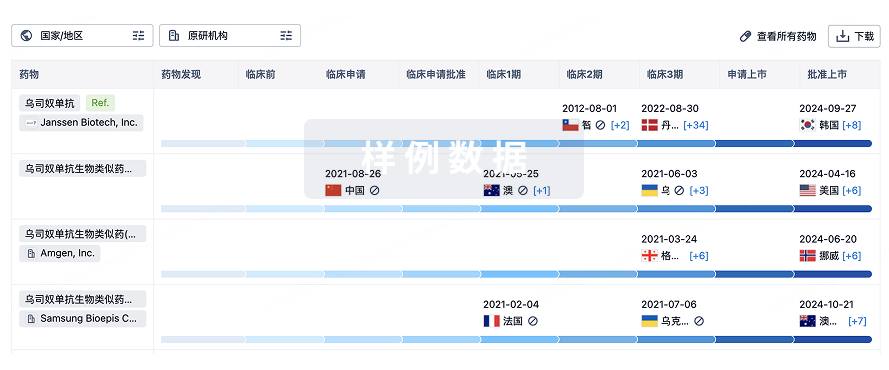预约演示
更新于:2025-08-21
Flagellin
更新于:2025-08-21
概要
基本信息
非在研机构- |
权益机构- |
最高研发阶段临床前 |
首次获批日期- |
最高研发阶段(中国)- |
特殊审评- |
关联
100 项与 Flagellin 相关的临床结果
登录后查看更多信息
100 项与 Flagellin 相关的转化医学
登录后查看更多信息
100 项与 Flagellin 相关的专利(医药)
登录后查看更多信息
107
项与 Flagellin 相关的文献(医药)2025-06-18·APPLIED AND ENVIRONMENTAL MICROBIOLOGY
Harnessing flagellin of
Ligilactobacillus agilis
as a surface display scaffold for an HIV-1 epitope
Article
作者: Dean, Gregg A. ; Suzuki, Shunya ; Kajikawa, Akinobu
ABSTRACT:
Lactic acid bacteria (LAB) are promising mucosal vaccine vectors due to their safety, immunostimulatory properties, and the availability of genetic tools for certain strains. Bacterial flagellin has attracted attention as both a versatile scaffold for antigen surface display and a potent adjuvant via Toll-like receptor 5 (TLR5) activation. Despite these advantages, LAB-derived flagellin remains largely unexplored as an antigen display platform. In this study, we demonstrate the potential of flagellin (FliC2) from
Ligilactobacillus agilis
, one of the few flagellated LAB species, as a scaffold for the surface display of the HIV-1 membrane-proximal external region (MPER) epitope. Recombinant
L. agilis
strains were engineered to express FliC2 with the MPER epitope inserted at various positions within its hypervariable domain, identifying optimal sites for effective surface display. To enhance the adjuvant activity of FliC2, specific amino acid substitutions were introduced into the TLR5 recognition site, resulting in improved TLR5-stimulating activity
in vitro
. Immunization of mice with MPER-displaying
L. agilis
strains induced MPER-specific IgA and IgG responses, demonstrating the efficacy of the
L. agilis
flagellin-based display platform in eliciting both mucosal and systemic immune responses. This study is the first to demonstrate LAB-derived flagellin as an antigen display scaffold, highlighting
L. agilis
flagellin as a promising platform for mucosal vaccine development.
IMPORTANCE:
Lactic acid bacteria (LAB) are promising delivery vehicles of active molecules, and surface display systems are gaining interest for efficiently displaying heterologous peptides and proteins. Flagellin, a TLR5 agonist, has been widely used as an adjuvant and an antigen scaffold, making it a potentially valuable platform for such systems. However, the potential of LAB-derived flagellin as a surface display scaffold remains largely unexplored. This study demonstrates that flagellin from
Ligilactobacillus agilis
, a flagellated LAB species, effectively functions as an antigen display platform, eliciting mucosal and systemic immune responses. Our findings highlight the feasibility of LAB-derived flagellin as a versatile tool for surface display of heterologous peptides, expanding its potential applications in vaccine development and mucosal immunotherapy.
2024-11-15·JOURNAL OF INFECTIOUS DISEASES
Triggering Toll-Like Receptor 5 Signaling During Pneumococcal Superinfection Prevents the Selection of Antibiotic Resistance
Article
作者: Gjini, Erida ; Baldry, Mara ; Gibson, Paddy S ; Costa, Charlotte ; Veening, Jan-Willem ; Sirard, Jean-Claude
Abstract:
Toll-like receptor 5 (TLR5) signaling plays a key role in antibacterial defenses. We previously showed that respiratory administration of flagellin, a potent TLR5 agonist, in combination with amoxicillin (AMX) improves the treatment of primary pneumonia or superinfection caused by AMX-sensitive or AMX-resistant Streptococcus pneumoniae. Here, the impact of adjunct flagellin therapy on antibiotic dose/regimen and the selection of antibiotic-resistant S. pneumoniae was investigated using superinfection with isogenic antibiotic-sensitive and antibiotic-resistant bacteria and population dynamics analysis. Our findings demonstrate that flagellin allows for a 200-fold reduction in the antibiotic dose, achieving the same therapeutic effect observed with antibiotic alone. Adjunct treatment also reduced the selection of antibiotic-resistant bacteria in contrast to the antibiotic monotherapy. A mathematical model was developed that captured the population dynamics and estimated a 20-fold enhancement immune-modulatory factor on bacterial clearance. This work paves the way for the development of host-directed therapy and refinement of treatment by modeling.
2024-08-01·Chinese Clinical Oncology
AB020. Flagellin synergistically enhances anti-tumor effect of EGFRvIII peptide in a glioblastoma-bearing mouse brain tumor model
Article
作者: Choi, Jin-Myung ; Jung, Shin ; Liu, Zhi-Peng ; Lim, Sa-Hoe
BACKGROUND:
Glioblastoma (GBM) is the most aggressive type of brain tumor with heterogeneity and strong invasive ability. Treatment of GBM has not improved significantly despite the progress of immunotherapy and classical therapy. Epidermal growth factor receptor variant III (EGFRvIII), one of GBM-associated mutants, is regarded as an ideal therapeutic target in EGFRvIII-expressed GBM patients because it is a tumor-specific receptor expressed only in tumors. Flagellin B (FlaB) originated from Vibrio vulnificus, is known as a strong adjuvant that enhances innate and adaptive immunity in various vaccine models. This study investigated whether FlaB synergistically could enhance the anti-tumor effect of EGFRvIII peptide (PEGFRvIII).
METHODS:
EGFRvIII-GL261/Fluc cells were used for GBM-bearing mouse brain model. Cell-bearing mice were inoculated with phosphate-buffered saline (PBS), FlaB alone, PEGFRvIII alone, and PEGFRvIII plus FlaB. Tumor growth based on magnetic resonance imaging (MRI) and the survival rate was investigated. T cell population was examined by flow cytometry analysis. Both cleaved caspase-3 and CD8+ lymphocytes were shown by immunohistochemistry (IHC) staining.
RESULTS:
The PEGFRvIII plus FlaB group showed delayed tumor growth and increased survival rate when compared to other treatment groups. As evidence of apoptosis, cleaved caspase-3 expression and DNA disruption were more increased in the PEGFRvIII plus FlaB group than in other groups. In addition, the PEGFRvIII plus FlaB group showed more increased CD8+ T cells and decreased Treg cells than other treatment groups in the brain.
CONCLUSIONS:
FlaB can enhance the anti-tumor effect of PEGFRvIII by increasing CD8+ T cell response in a mouse brain GBM model.
100 项与 Flagellin 相关的药物交易
登录后查看更多信息
研发状态
10 条进展最快的记录, 后查看更多信息
登录
| 适应症 | 最高研发状态 | 国家/地区 | 公司 | 日期 |
|---|---|---|---|---|
| 移植物抗宿主病 | 临床前 | 美国 | 2012-11-15 |
登录后查看更多信息
临床结果
临床结果
适应症
分期
评价
查看全部结果
| 研究 | 分期 | 人群特征 | 评价人数 | 分组 | 结果 | 评价 | 发布日期 |
|---|
No Data | |||||||
登录后查看更多信息
转化医学
使用我们的转化医学数据加速您的研究。
登录
或

药物交易
使用我们的药物交易数据加速您的研究。
登录
或

核心专利
使用我们的核心专利数据促进您的研究。
登录
或

临床分析
紧跟全球注册中心的最新临床试验。
登录
或

批准
利用最新的监管批准信息加速您的研究。
登录
或

生物类似药
生物类似药在不同国家/地区的竞争态势。请注意临床1/2期并入临床2期,临床2/3期并入临床3期
登录
或

特殊审评
只需点击几下即可了解关键药物信息。
登录
或

生物医药百科问答
全新生物医药AI Agent 覆盖科研全链路,让突破性发现快人一步
立即开始免费试用!
智慧芽新药情报库是智慧芽专为生命科学人士构建的基于AI的创新药情报平台,助您全方位提升您的研发与决策效率。
立即开始数据试用!
智慧芽新药库数据也通过智慧芽数据服务平台,以API或者数据包形式对外开放,助您更加充分利用智慧芽新药情报信息。
生物序列数据库
生物药研发创新
免费使用
化学结构数据库
小分子化药研发创新
免费使用
